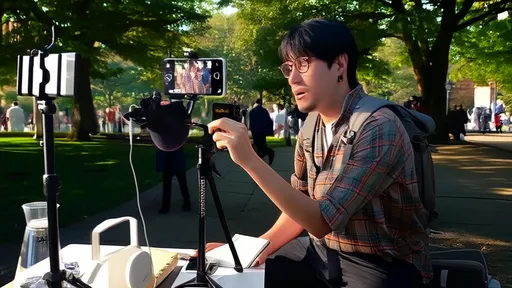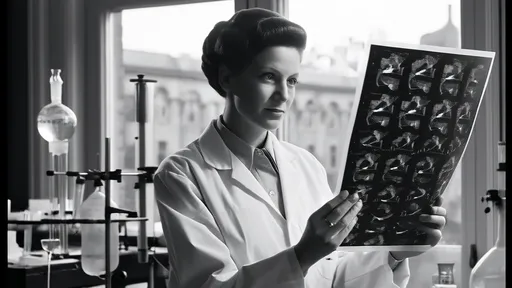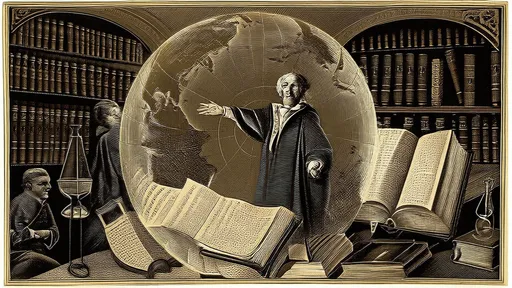The story of Rosalind Franklin stands as one of the most poignant narratives in the history of science - a brilliant mind whose crucial contributions were nearly erased from the annals of one of humanity's greatest discoveries. Her work on the structure of DNA should have earned her a place among the most celebrated scientists of the 20th century, yet for decades her name remained overshadowed by her male colleagues.
Born in 1920 to an influential Anglo-Jewish family in London, Franklin displayed exceptional intellectual abilities from an early age. Her education at St Paul's Girls' School nurtured her talents in science and languages, setting her on a path that would eventually lead to groundbreaking work in X-ray crystallography. After completing her PhD at Cambridge University, she spent several formative years in Paris perfecting her techniques before returning to England to take up a position at King's College London.
It was at King's College that Franklin made her most significant contributions to science. Tasked with applying X-ray diffraction techniques to study DNA fibers, she produced photographs of unprecedented clarity that would prove instrumental in deciphering the molecule's structure. Her famous Photo 51, taken in May 1952, revealed the telltale X-shaped pattern that unmistakably indicated a helical structure. This image, along with her meticulous measurements and analysis, provided crucial evidence that others would later use to construct the double helix model.
Franklin's approach to science was characterized by rigorous methodology and caution. Where others might have rushed to publish speculative models, she insisted on collecting comprehensive data before drawing conclusions. This careful, evidence-based approach led her to initially dismiss some early helical models as insufficiently supported. Her reluctance to speculate without firm evidence, while scientifically admirable, may have contributed to her being somewhat sidelined in the competitive race to solve DNA's structure.
The circumstances surrounding how Franklin's data reached James Watson and Francis Crick remain controversial to this day. Without her knowledge or consent, her research and Photo 51 were shown to the Cambridge duo by Maurice Wilkins, her colleague at King's College with whom she had a strained professional relationship. This unauthorized sharing of her work provided Watson and Crick with critical insights that accelerated their own model-building efforts.
When Watson and Crick published their landmark 1953 paper in Nature announcing the double helix structure of DNA, they included only a passing reference to Franklin's "unpublished observations." The full extent of her contribution went unacknowledged at the time. Even more striking is that in Watson's later book "The Double Helix," Franklin was portrayed in unflattering terms that many consider misogynistic, further distorting historical perceptions of her role.
Franklin herself moved on from DNA research to make significant contributions to the study of viruses, particularly the tobacco mosaic virus and polio virus. Her work in this field was highly regarded and might well have earned her Nobel recognition had she lived longer. Tragically, she died of ovarian cancer in 1958 at just 37 years old, four years before Watson, Crick and Wilkins received the Nobel Prize for their work on DNA's structure.
The Nobel Prize cannot be awarded posthumously, leaving unanswered the question of whether Franklin would have shared in the honor had she lived. Many historians of science now believe she certainly deserved recognition for her crucial experimental work. The fact that the Nobel committee typically awards no more than three people for a single discovery further complicates this historical injustice.
In recent decades, there has been a concerted effort to restore Franklin to her rightful place in the DNA discovery narrative. Her meticulous notebooks reveal a scientist of extraordinary ability and dedication. Where Watson's account portrayed her as resistant to helical models, her notes show she was actually close to solving the structure herself. She had determined that DNA had two forms (A and B), correctly identified the sugar-phosphate backbone as being on the outside, and had calculated key parameters about the molecule's dimensions.
Franklin's story resonates powerfully in discussions about women in science. She worked during an era when female scientists faced significant institutional barriers and gender discrimination. The patronizing attitudes she encountered at King's College - where she was reportedly excluded from certain social gatherings and not allowed to eat in the senior common room - created a hostile work environment that undoubtedly affected her experience and opportunities.
What makes Franklin's case particularly striking is that unlike many other overlooked women scientists, she was not working in isolation or obscurity. She was at a prestigious institution, doing cutting-edge research on one of the most important scientific questions of the time. Yet her contributions were still marginalized in the historical record until relatively recently.
The rehabilitation of Franklin's reputation has been gradual but significant. Today, many institutions honor her legacy through fellowships, buildings, and awards named in her memory. The Royal Society established the Rosalind Franklin Award to support women in science, and numerous biographies have helped correct the historical record. Her story has become emblematic of the systemic barriers women have faced in scientific recognition.
Beyond the gender dynamics, Franklin's story raises important questions about scientific ethics and credit. The use of her data without permission or proper acknowledgment was clearly problematic, even by the standards of the time. The case continues to serve as a cautionary tale about collaboration, competition, and professional conduct in scientific research.
Franklin's scientific legacy extends beyond the DNA work for which she is now belatedly famous. Her virus research demonstrated the same exceptional experimental skills and intellectual rigor she brought to the study of DNA. Colleagues who worked with her on viruses remembered her as a generous collaborator and inspiring mentor, contrasting sharply with Watson's unflattering portrayal.
Perhaps the greatest tragedy of Franklin's story is that she never had the opportunity to see how profoundly her work shaped modern biology. The double helix structure she helped reveal has become the foundation of molecular biology, genetics, and biotechnology. The fields that grew from this discovery have transformed medicine, agriculture, and our understanding of life itself.
As we continue to reassess scientific history, Rosalind Franklin's story serves as both an inspiration and a warning. It reminds us of the importance of recognizing all contributors to major discoveries, regardless of gender or institutional politics. It challenges us to create a more equitable scientific culture where credit is properly assigned and diverse voices are valued. And it stands as testament to the enduring power of meticulous, dedicated research - even when that research doesn't receive immediate recognition.
Franklin's life and work embody the very best of scientific inquiry: precision, perseverance, and intellectual honesty. While history may have initially failed her, the growing recognition of her contributions ensures that her name will be remembered alongside the greatest scientific minds of her generation. In laboratories around the world where DNA research continues to unfold, her legacy lives on - not as a footnote to someone else's discovery, but as a pioneering scientist in her own right.

By /Jul 2, 2025

By /Jul 2, 2025

By /Jul 2, 2025

By /Jul 2, 2025

By /Jul 2, 2025

By /Jul 2, 2025

By /Jul 2, 2025

By /Jul 2, 2025

By /Jul 2, 2025

By /Jul 2, 2025

By /Jul 2, 2025

By /Jul 2, 2025

By /Jul 2, 2025

By /Jul 2, 2025

By /Jul 2, 2025

By /Jul 2, 2025

By /Jul 2, 2025

By /Jul 2, 2025

By /Jul 2, 2025

By /Jul 2, 2025